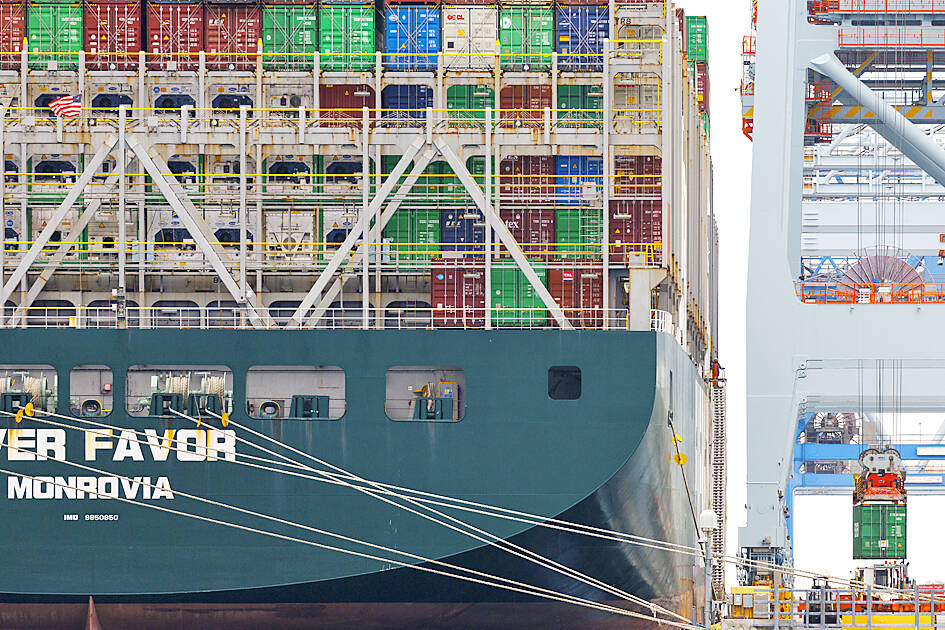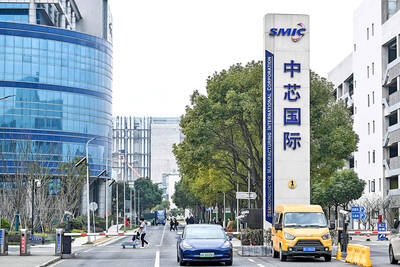US President Donald Trump said the 25 percent tariffs on Canada and Mexico are on track to go into place on Tuesday next week, and that he would impose an additional 10 percent tax on Chinese imports, moves that would deepen his fight with the largest US trading partners.
The president paused the sweeping duties on Canada and Mexico on Feb. 3 for one month after the two countries’ leaders announced new border security measures.
Trump said in a social media post on Thursday that drugs from the US’ North American neighbors are still entering “at very high and unacceptable levels.”

Photo: EPA-EFE
“We cannot allow this scourge to continue to harm the USA, and therefore, until it stops, or is seriously limited, the proposed TARIFFS scheduled to go into effect on MARCH FOURTH will, indeed, go into effect, as scheduled,” Trump wrote. “China will likewise be charged an additional 10 percent tariff on that date.”
The new tariffs on China come on top of a previous 10 percent duty he allowed to take effect earlier this month, when he delayed tariffs on Canada and Mexico. The 25 percent tariffs apply to all Canadian and Mexican imports, except for energy products from Canada, which are to be taxed at 10 percent.
“It’s 10 plus 10, a second 10,” Trump said in the Oval Office. “I think you’re going to see actually drug stopping because the countries should not be allowing the drugs to come into the United States of America. We’re not going to allow it to happen.”
Trump’s brinkmanship puts North America back on the precipice of a trade war, which economists say would hurt US growth, worsen inflation and possibly spark recessions in Mexico and Canada. Those countries plus China are the three biggest sellers to the US. If there is no last-minute reprieve, Tuesday would see taxes ramped up on more than US$1 trillion of imports.
Trump’s latest tariff threat rattled financial markets. The US dollar soared on Thursday, sending Canada’s dollar, Mexico’s peso and China’s offshore yuan sliding. The S&P 500 fell 1.6 percent, as investors worried about the impact of trade barriers on the economy.
“The April Second Reciprocal Tariff date will remain in full force and effect,” the president wrote on Thursday.
The tariffs on China are also related to its role in the fentanyl trade. Much illegal fentanyl is manufactured abroad and smuggled into the US through Mexico, with cartels often using Chinese components to make the drug, the US Drug Enforcement Administration has said. China has dismissed the issue as a “pretext” for Trump’s tariffs.
Chinese Minister of Commerce Wang Wentao (王文濤) on Thursday wrote to US Trade Representative Jamieson Greer to object to the tariffs.
The US, Canada and Mexico have integrated their supply chains in recent decades, from cars to produce, and new tariffs risk destabilizing the North American trade pact Trump signed during his first term.
Trade in goods and services between Canada and the US was about US$920 billion in 2023, while Mexico-US trade was nearly US$900 billion, US Department of Commerce data showed.
Trump had for the most part treaded more carefully on China — the third-largest US trading partner — during the initial weeks of his second term, speaking of his desire to reach a trade agreement with Beijing. Yet his latest pledge to tack on more tariffs risks worsening ties, along with efforts to step up investment restrictions on key products such as semiconductors.
The initial 10 percent tariff hike on China was expected to have only a limited effect on China’s growth in the near term, an analysis from Shu Chang (舒暢), Eric Zhu (朱懌) and and David Qu (曲天石) of Bloomberg Economics said.
“But higher, permanent tariffs would bring considerable pain,” they wrote in a research report earlier this month.
An increase to 60 percent would slash China’s exports to the US by almost 80 percent, putting 2.3 percent of GDP at risk in the medium term, they estimated.

NO BREAKTHROUGH? More substantial ‘deliverables,’ such as tariff reductions, would likely be saved for a meeting between Trump and Xi later this year, a trade expert said China launched two probes targeting the US semiconductor sector on Saturday ahead of talks between the two nations in Spain this week on trade, national security and the ownership of social media platform TikTok. China’s Ministry of Commerce announced an anti-dumping investigation into certain analog integrated circuits (ICs) imported from the US. The investigation is to target some commodity interface ICs and gate driver ICs, which are commonly made by US companies such as Texas Instruments Inc and ON Semiconductor Corp. The ministry also announced an anti-discrimination probe into US measures against China’s chip sector. US measures such as export curbs and tariffs

The US on Friday penalized two Chinese firms that acquired US chipmaking equipment for China’s top chipmaker, Semiconductor Manufacturing International Corp (SMIC, 中芯國際), including them among 32 entities that were added to the US Department of Commerce’s restricted trade list, a US government posting showed. Twenty-three of the 32 are in China. GMC Semiconductor Technology (Wuxi) Co (吉姆西半導體科技) and Jicun Semiconductor Technology (Shanghai) Co (吉存半導體科技) were placed on the list, formally known as the Entity List, for acquiring equipment for SMIC Northern Integrated Circuit Manufacturing (Beijing) Corp (中芯北方積體電路) and Semiconductor Manufacturing International (Beijing) Corp (中芯北京), the US Federal Register posting said. The

India’s ban of online money-based games could drive addicts to unregulated apps and offshore platforms that pose new financial and social risks, fantasy-sports gaming experts say. Indian Prime Minister Narendra Modi’s government banned real-money online games late last month, citing financial losses and addiction, leading to a shutdown of many apps offering paid fantasy cricket, rummy and poker games. “Many will move to offshore platforms, because of the addictive nature — they will find alternate means to get that dopamine hit,” said Viren Hemrajani, a Mumbai-based fantasy cricket analyst. “It [also] leads to fraud and scams, because everything is now

MORTGAGE WORRIES: About 34% of respondents to a survey said they would approach multiple lenders to pay for a home, while 29.2% said they would ask family for help New housing projects in Taiwan’s six special municipalities, as well as Hsinchu city and county, are projected to total NT$710.65 billion (US$23.61 billion) in the upcoming fall sales season, a record 30 percent decrease from a year earlier, as tighter mortgage rules prompt developers to pull back, property listing platform 591.com (591新建案) said yesterday. The number of projects has also fallen to 312, a more than 20 percent decrease year-on-year, underscoring weakening sentiment and momentum amid lingering policy and financing headwinds. New Taipei City and Taoyuan bucked the downturn in project value, while Taipei, Hsinchu city and county, Taichung, Tainan and Kaohsiung